Directional stimulation for Dystonic tremor
Objective: Is our aim to present our experience with bilateral directional thalamic DBS for DT. Background: Dystonic tremor(DT) is characterized by coexisting tremor and abnormal…High Dose Botulinum Toxin Therapy: Safety, Benefit and Endurance of Efficacy
Objective: To assess safety, therapeutic response and long-term benefit of higher dose Onabotulinum toxin A (OnaA). Background: Botulinum toxin therapy is a powerful tool for…Bilateral Globus pallidus interna Deep Brain Stimulation in Cranio-Cervical Dystonia (Meige syndrome) patient in Hong Kong
Objective: To report the first cranio- cervical dystonia (Meige syndrome) patient who received Deep Brain Stimulation (DBS) implant in Hong Kong. Background: Meige syndrome is…Rapid improvement in dystonia after pallidal deep brain stimulation in a patient with myoclonus-dystonia syndrome: A case report
Objective: Describe the time course of clinical response to bilateral globus pallidus internus (GPi) deep brain stimulation (DBS) in a patient with myoclonus-dystonia syndrome (M-D),…Safety of Iron Chelation in Patients with Brain Iron Overload
Objective: To assess the safety of iron chelation in the treatment of regional brain iron overload. Background: Excess brain iron is evident in neurodegenerative diseases…Pediatric Deep Brain Stimulation in Secondary Dystonia using Stereotactic Depth Electrode Targeting
Objective: The primary objective of our pediatric clinical research is to improve outcomes after deep brain stimulation for pediatric patients with secondary dystonia. We apply…Successful treatment of secondary dystonia with deep brain stimulation of the globus pallidus internus
Objective: Improving targeting accuracy in the treatment of secondary dystonia with DBS of GPi Background: Dystonia is a very disabling disease. Deep brain stimulation (DBS) of…Benefit and Weakness with botulinum toxin: time course and relationship.
Objective: To compare the timecourse of and relationship between benefit and weakness after botulinum toxin (BoNT) injection. Background: The timecourse of benefit onset and duration…GPi DBS does not affect sensory thresholds in hereditary/idiopathic dystonia
Objective: Despite the widespread use of DBS for dystonia, little is known about its effects on non-motor symptoms such as dystonia-related pain. Here we provide…Impact of pallidal deep brain stimulation on activities of daily living in patients with craniocervical dystonia – a multi-center survey
Objective: To assess the impact of pallidal deep brain stimulation (DBS) on activities of daily living (ADL) in patients with primary craniocervical dystonia (CD). Background:…
- « Previous Page
- 1
- …
- 20
- 21
- 22
- 23
- 24
- …
- 35
- Next Page »
